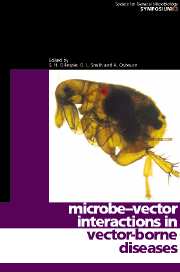Book contents
- Frontmatter
- Contents
- Contributors
- Editors' Preface
- 1 Vector-borne diseases
- 2 Evolution of tick-borne disease systems
- 3 Insect transmission of viruses
- 4 RNA-based immunity in insects
- 5 Specificity of Borrelia–tick vector relationships
- 6 Bunyavirus/mosquito interactions
- 7 How do mosquito vectors live with their viruses?
- 9 Vector competence
- 9 Environmental influences on arbovirus infections and vectors
- 10 Vector immunity
- 11 Transmission of plant viruses by nematodes
- 12 Wolbachia host–symbiont interactions
- 13 Pathogenic strategies of Anaplasma phagocytophilum, a unique bacterium that colonizes neutrophils
- 14 Interactions of Yersinia pestis with its flea vector that lead to the transmission of plague
- 15 Transgenic malaria
- 16 Vaccines targeting vectors
- Index
9 - Environmental influences on arbovirus infections and vectors
Published online by Cambridge University Press: 06 July 2010
- Frontmatter
- Contents
- Contributors
- Editors' Preface
- 1 Vector-borne diseases
- 2 Evolution of tick-borne disease systems
- 3 Insect transmission of viruses
- 4 RNA-based immunity in insects
- 5 Specificity of Borrelia–tick vector relationships
- 6 Bunyavirus/mosquito interactions
- 7 How do mosquito vectors live with their viruses?
- 9 Vector competence
- 9 Environmental influences on arbovirus infections and vectors
- 10 Vector immunity
- 11 Transmission of plant viruses by nematodes
- 12 Wolbachia host–symbiont interactions
- 13 Pathogenic strategies of Anaplasma phagocytophilum, a unique bacterium that colonizes neutrophils
- 14 Interactions of Yersinia pestis with its flea vector that lead to the transmission of plague
- 15 Transgenic malaria
- 16 Vaccines targeting vectors
- Index
Summary
INTRODUCTION
In 430 BC, Hippocrates said ‘Whoever would study medicine aright must learn of the following subjects. First, he must consider the effect of the seasons of the year and the differences between them. Second, he must study the warm and cold winds, both those which are common to every country and those peculiar to a particular locality.’
From this we can see that the influence of climate and environmental variables on infectious diseases has been a topic of interest to medicine for over 2000 years. Recently there has been an increase in this interest spurred on by the various climate change scenarios that have been put forward and highlighted by the fact that 9 of the 10 warmest years on record have occurred since 1990, thereby supporting the concept of ongoing climate change. Furthermore, recent climate models project an increase in global mean temperature of between 1.4 and 5.8 °C during the 21st century (Intergovernmental Panel on Climate Change, 2001). It is further predicted that maximum warming will occur at high latitudes and during the winter, and that nighttime temperatures will increase more than daytime temperatures (Karl et al., 1993; Kukla & Karl, 1993; McMichael et al., 1996).
In the context of vector-borne diseases, these predicted temperature increases, and accompanying climatic changes in rainfall patterns and extreme weather events (for example increased windiness), are likely to have a variable but significant effect. By definition, vector-borne diseases possess a vector stage, usually an insect, tick, crustacean or mollusc, which is poikilothermic and therefore peculiarly liable to be profoundly influenced by climatic variables, especially temperature.
- Type
- Chapter
- Information
- Microbe-vector Interactions in Vector-borne Diseases , pp. 181 - 198Publisher: Cambridge University PressPrint publication year: 2004
- 1
- Cited by



